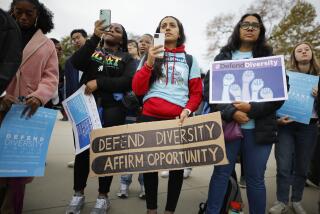A Judge of Character : Although he’s blind, David Tatel skis, runs and climbs mountains. By summer’s end, he may be a top jurist too.
- Share via
WASHINGTON — He is surrounded by the trappings of power: the designer building afew blocks from the White House, the Wall Street Journals in the waiting room, the corner office overlooking an atrium of glass and tubular steel.
But David S. Tatel is not impressed by them.
For one thing, Tatel, a senior partner at Hogan & Hartson, an influential Washington law firm, has devoted his professional life to the least powerful members of society, poor children in urban areas.
For another, Tatel is blind. He lost his sight after law school to retinitis pigmentosa.
Nominated to fill the spot vacated by Supreme Court Justice Ruth Bader Ginsburg on what is regarded as the nation’s second most important court--the U.S. Court of Appeals for the District of Columbia Circuit--Tatel, 52, has already reached professional and personal heights achieved by few Americans.
Married with four grown children, he has run in marathons, climbs mountains in Oregon, skis yearly in Colorado and is a passionate fan of the Baltimore Orioles, whose games he regularly attends.
“As the kids say, he’s awesome,” said Nan Aron, executive director of the Alliance for Justice, a grouping of environmental, consumer and civil rights legal organizations.
Tatel declined to be interviewed for quotation, citing his confirmation hearings later this summer before the U.S. Senate.
But there was no shortage of testimonials from others.
“I would be hard-pressed to find another advocate who has done more for the education of minority children than David, other than (the late Supreme Court Justice) Thurgood Marshall,” said Shirley Hufstedler, a former secretary of education and currently a partner in the Los Angeles firm of Hufstedler & Kaus.
As director of the Office for Civil Rights in the then-Department of Health, Education and Welfare from 1977-79, Tatel cleared a huge backlog of cases left by the Nixon and Ford Administrations.
At Hogan & Hartson, he heads a unique “education group” of 15 lawyers that represents school districts around the nation.
“He’s a pioneer thinker on school desegregation,” said Colleen O’Connor, a former colleague at HEW who works for the Institute for Policy Studies, a Washington think tank. “He came into the Office for Civil Rights and reinvented it under (HEW Secretary) Joe Califano. In private practice, he’s produced innovative plans in St. Louis and Milwaukee.”
“He was terrific,” agreed Califano, now director of the Center on Addiction and Substance Abuse at Columbia University. “He knew all the minefields and cared about getting the job done, not just getting good press or pleasing one constituency or another.”
Some tributes came from unlikely sources.
“Given this Administration’s propensity for such factors as political correctness, it wouldn’t surprise me if his blindness was a factor, but it’s emphatically true that Tatel has the qualifications to be nominated without that,” said Clint Bolick, litigation director of the Institute for Justice.
Known for firing the first shots in the fusillade that brought down the nomination of Lani Guinier as assistant attorney general for civil rights, Bolick added, however: “If Tatel transports his personal ideology to the bench, we’re in for a pretty wild ride.”
*
Tatel has been associated with classic remedies for segregation--pairing white and black schools within cities when possible, across city-suburb lines when not.
Preferring carrots to sticks, he has sought to minimize reliance on involuntary busing, instead improving black schools to attract white students.
But critics question whether the remedies have helped.
Opponents have dubbed a new, $32-million high school in Kansas City, Mo.--part of a court-ordered $1.2-billion desegregation plan in a district represented by Hogan & Hartson--an educational Taj Mahal.
“City schools are still about 75% black, and with all the money spent, the results are very minimal,” said Mark Bredemeier, general counsel of the Landmark Legal Foundation of Kansas City.
Hogan & Hartson attorneys argue that the plan, in effect for only a few years, needs more time.
Tatel imbibed his belief in the beneficent power of government from like-minded parents, who moved to Washington during World War II.
A member of the generation that came of age under John F. Kennedy, Tatel was confirmed in his ideals of public service at summer jobs in Washington in the early 1960s. He heard weekly addresses by Cabinet officers and met the President at the White House.
Although his first job after graduating from the University of Chicago law school was with an old-guard, corporate firm, Sidley & Austin, Tatel almost immediately began pro bono work for the Chicago Urban League. In 1967, he wrote his first brief in support of a desegregation case, in Waukegan, Ill.
*
His path away from corporate lawyerdom was settled the following year, when he visited segregated Chicago schools as a member of a mayoral committee probing the riots that followed the assassination of the Rev. Martin Luther King Jr.
“Our first child was born the day the riot was started,” he recalled in an interview with Education Week in May, before his judicial nomination. “We were in the hospital and could see the smoke billowing up on the South Side.”
Four years later, Tatel could no longer see anything.
But his disability did not impede him.
If anything, friends and colleagues said, his blindness has deepened his empathy with those he represents and spurred him to greater achievement.
“He is the least handicapped man I know,” Hufstedler said. “Like the (late Supreme Court Justice) John Harlan when he lost his sight, David is able to construct and hold in his memory complicated legal documents.
“Because he can’t see people, he sees through them. He picks up nuances that those of us who are sighted cannot.”
To keep up with the mountains of documents lawyers must consume, Tatel has a reader and uses a computer device that translates printed material into audio that sounds like someone speaking English with a slight foreign accent.
He has expressed frustration that he can’t just pick up a newspaper or book on an airplane. But for the most part, he has not allowed his blindness to inhibit a very full life.
He goes to the movies and even photo exhibitions with his wife, Edith, a teacher, and delights in describing to friends what he’s “seen.”
He has climbed mountains, holding one end of a traditional white cane while a companion holds the other.
In Aspen, Colo., he discovered a way of continuing the downhill skiing he began before losing his eyesight. He puts a radio transmitter in his ear and a guide skiing behind him--most often his son, Josh, or Emily, the youngest of his three daughters--calls the turns.
An accomplished runner, Tatel has completed the New York and Marine Corps marathons and gone the equivalent of 1 1/2 times around the world in the company of Lawrence M. O’Rourke, a neighbor in Chevy Chase, Md.
O’Rourke, political correspondent for McClatchy Newspapers, has been Tatel’s seeing-eye jogger for nearly 30 years.
They run joined by two heavy duty shoestrings tied together, then attached to Tatel’s upper left arm and O’Rourke’s right.
Asked if it wasn’t a strain to run this way, O’Rourke joked that his only complaint was about the “sometimes outlandish ideas” Tatel advances in friendly arguments they conduct each morning about everything from vacation spots to the nature of quarks.
“It’s a great way to stretch our thinking,” O’Rourke said. “We try to find extremist perspectives irrespective of personal belief and then go at it for an hour or so.
“He’ll be a great judge because he has an incredible temperament, the ability to see all sides of an issue and to see the consequences of actions.”
*
The court to which Tatel has been named is considered the second most powerful court in the nation. It is where individuals sue the government to overturn the decisions of federal regulatory agencies.
Nominations to the court are a relatively free pick by Presidents, who do not have to defer to the choice of a senator because Washington, D.C., has none.
As a result, the 12-member panel has been extremely diverse politically, as evidenced by the judges who have ascended from it to the Supreme Court in recent years: Ginsburg, Antonin Scalia and Clarence Thomas.
Many colleagues thought Tatel, known for his negotiating skills, would play a role similar to that of Ginsburg.
“He will have the (same) kind of talent to run shuttle diplomacy among the factions on the court,” Hufstedler said.
Unlike the latest Supreme Court nominee, Stephen G. Breyer, who was considered by some to be excessively cerebral, Tatel is unlikely to have to persuade those at his confirmation hearings that he can be a judge with both “a heart and a head.”
Warm is the adjective most frequently used to describe him.
“He gives a damn as a human being,” said Gerry Gunther, a professor of constitutional law at Stanford, where Tatel taught during a 1991-92 sabbatical.
“He’s a good soul,” said Dick Beattie, former HEW counsel and now chairman of the prestigious New York law firm, Simpson, Thatcher.
“I can’t think of a better appointment,” Califano said. “This is as good as any Clinton has made and one he’ll be very proud of. David will make history.”
More to Read
Sign up for Essential California
The most important California stories and recommendations in your inbox every morning.
You may occasionally receive promotional content from the Los Angeles Times.










